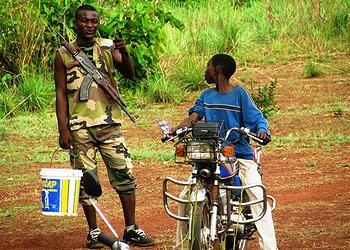
NEW YORK, New York, December 16, 2013 (ENS) – Natural resources, which can fuel and finance armed groups, can also play a major role in bringing about sustainable peace, the United Nations says in a new report urging governments and partners to integrate natural resource management in post-conflict programs.
Incorporating natural resources in peacebuilding efforts can help to ease potential disputes over land or water and provide green jobs for former soldiers, finds a new joint report released by UN Development Programme and the UN Environment Programme.

“When helping former fighters and their communities to start new lives after a conflict, it is often critical to help them turn existing natural resources into economic opportunities,” said Jordan Ryan, UNDP assistant administrator and director of the Bureau for Crisis Prevention and Recovery.
“However, natural resources need to be managed properly as part of a well thought-out peace process,” he said referring to minerals, oils, gas and timber.
According to the report, “The Role of Natural Resources in Disarmament, Demobilization and Reintegration – Addressing Risks and Seizing Opportunities,” plans for the fair management and distribution of natural resources are usually excluded from peace negotiations and disarmament, demobilization and reintegration (DDR) programmes, which have become an integral part of the UN’s post-conflict peace consolidation over the last 20 years.
For example, in Sierra Leone, natural resources, which now make up 90 percent of the country’s exports, were implicated in the country’s civil war, according to the authors.
Yet, as an example of the creation of “green jobs” in a post-conflict setting, after the signing of the peace agreement in Nepal in 2006, approximately 19,600 former Maoist fighters awaiting integration into the Nepalese National Army were taught how to upgrade water systems and improve cooking stoves in their own cantonment camps.
The report finds that given one-third of UN peacekeeping operations since 1990 have taken place in areas where the conflicts have been driven by natural resources, effective natural resource management has the potential to reduce risk of inflaming conflicts.
Case studies featured in the report include some of the most difficult situations, such as that of former Lord’s Resistance Army combatants and access to land in Northern Uganda, and criminality in Colombia, which includes land seizures by armed groups for illicit narcotics cultivation and deforestation.
The authors also note the need to consider access to natural resources among vulnerable groups, such as women, who play an important role as they are primarily responsible for providing food, water and other basic resources for households.
“Natural resources, in and of themselves, are rarely a cause of conflict. However, when they are mismanaged and misused – for instance, to finance the rise of rebels or militias, or to promote specific group interests – they can have a multiplier effect on other causes and drivers, including underlying social divisions, governance deficits, fragile institutions and more,” wrote Ryan and Ibrahim Thiaw, deputy executive director of the United Nations Environment Programme, in their joint introduction to the report.
“The negative impact of natural resources is far from inevitable, even in the most challenging environments,” wrote Ryan and Thiaw.

“A number of countries featured in the report, including Afghanistan, Indonesia, Liberia, and Rwanda, have leveraged natural resources into a platform for the generation of jobs, revenues, basic services, and infrastructure. Their experiences demonstrate the enormous potential – as yet not fully realized – by many other fragile countries to transform their natural resource wealth into the peace dividends needed to unite fractured societies and fuel post-conflict recovery,” Ryan and Thiaw wrote.
The report recommends incorporating key elements of the relationship between natural resources and armed forces and groups into conflict analysis, assessments and planning for disarmament, demobilization and reintegration.
It also recommends targeting opportunities to rehabilitate infrastructure that will improve the potential for natural resources to contribute to employment creation
and reintegration, keeping “a gender-responsive approach” in mind.
“For example,” states the report, “the rehabilitation of irrigation systems and local roads may drive the growth and improvement in productivity of markets for agricultural
goods and products. Potential projects could also include the construction of food storage facilities and processing equipment, which can further increase the
resilience of agricultural livelihoods to any changes in climate and market conditions, thereby preparing communities for long-term development activities.”
Disarmament, demobilization and reintegration planning teams should include sustainability assessments, or environmental screenings, for reintegration programs to fully assess their impact on the availability and accessibility of natural resources, the report advises.
This may include assessments of the carrying capacity of lands for livestock, availability and accessibility of water resources for drinking, sanitation and irrigation, and the use of best management practices to prevent the degradation of natural resources and to maximize their productivity.
Access to land and security of land tenure should also be assessed to avoid any conflict that could arise between individuals or groups as a result of reintegration activities, advises the report.
After several further recommendations, the authors emphasize that capacity-building efforts to ensure that national disarmament, demobilization and reintegration commissions, and the UN actors and donors who support them, are able to successfully mitigate risks and take advantage of opportunities.
The report reflects UNDP and UNEP’s integrated and multidimensional approach to post-conflict recovery, which includes support to livelihoods and economic recovery, social cohesion, institutional capacity development, restoration of local governance, and environmental sustainability.
This report was made possible by funding from the European Union and the governments of the Netherlands and Finland.
Copyright Environment News Service (ENS) 2013. All rights reserved.
© 2013, Environment News Service. All rights reserved. Content may be quoted only with proper attribution and a direct link to the original article. Full reproduction is prohibited.
